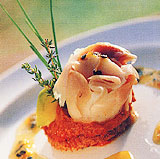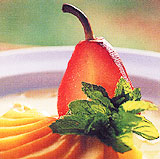|
|
 |
 |
| 03 May 2005 |
Beginners Guide - Small Kitchen Tools
This is the second installment in the Beginners guide to the kitchen.
In this insallment well be looking at Small kitchen tools.
The trussing needle
This is a needle which is approximately 15 cm long and very sturdy. It
can take a butcher’s twine.
The needle may be straight or bent, like a sail maker’s needle. It is used for
sowing the bally cavity of a chicken or a lamb, veal or pork carcasse closed.
The needle can also be used to pierce the leg joint of a chicken or turkey and
help to truss (shape) the bird by tying the legs and wing joints together and
pushing the breast outwards. This is mostly used in display birds for
showpieces on a cold buffet.
The lemon zester
This tool allows the chef to peel long, very thin, strips from the skin of a
lemon or orange. These strips can be used as garnish or for flavouring.
The lemon rinder
A lemon rinder produces a thicker strip of skin from the lemon or orange and is
used for garnishing.
The apple corer
This tool is pushed through the center of the apple to punch out the core. It
can also be used to
produce cylindrical shapes from potatoes or other vegetables.
Different scoops
The melon baler or scoop – has two ball scoops, one on each
end of the handle. The larger scoop is used for making lemon balls, or
"Parisienne" ball shapes while the "Noisette" ball shape is the size of a hazel
nut and produces small balls.
The butcher steel or sharpening rod
This is a finely grooved rod like a fine file and it has a sturdy
handle and cross piece, to avoid that the blade can hit your hand during the
sharpening process. The knife is slid from the heel to the tip at a 30 Degree
angle and under firm pressure across the grooves. You do this from both sides
of the knife. This polishes the sharpened edge and keeps the knife sharp. Under
no circumstances should this steel be stuck in the sash of the apron, as the
handle will push upwards into your abdomen and hurt you badly.
A Oyster opener
This is a tool which has a short, sturdy, triangular blade. It is slipped
between the shell halves
(valves) of a mussle and the handle is twisted to lever the halves apart,
thereby opening the oyster.
A swivel peeler or speed peeler
This is used for peeling all kinds of fruits and may be used in both
directions. A little scoop at the
end of the blade is used to scoop rotten pieces or imperfections from the fruit
or potato.
These are the most commonly used small tools in the kitchen.
|
|
 |
 |
|
|
|




